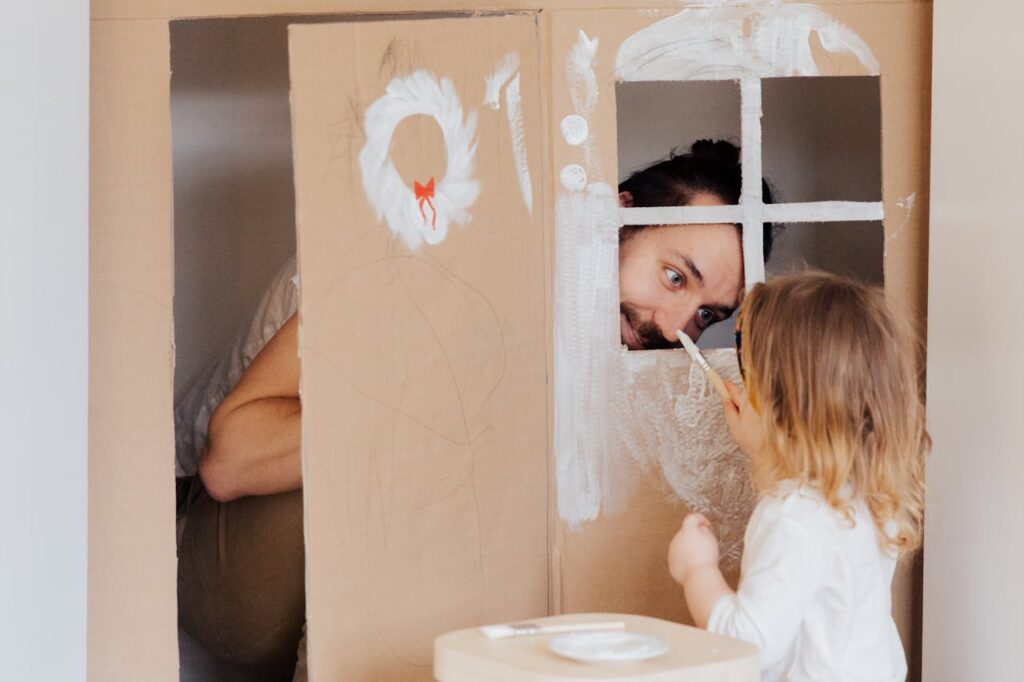Introduction
Picture this: It’s a rainy Saturday morning, and instead of hearing “I’m bored!” for the hundredth time, you hear giggles and excited chatter from the kitchen. Your toddler is creating masterpieces with yogurt paint, your preschooler is building a cardboard castle, and your teenager is actually putting down their phone to help design a recycled art sculpture. This isn’t a fantasy – it’s what happens when you discover the magic of DIY educational crafts using everyday materials.
As parents, we’re constantly juggling soccer practices, homework battles, and screen time negotiations. But what if I told you that transforming ordinary household items into extraordinary learning adventures could solve multiple parenting challenges at once? You’d get educational value, family bonding time, and creative expression all rolled into one activity that costs practically nothing.
Why DIY Educational Crafts Are Your Secret Parenting Superpower
Let’s face it – traditional learning doesn’t work for every child. Some kids are kinesthetic learners who need to touch, build, and create to truly understand concepts. Others are visual learners who grasp ideas better when they can see and manipulate materials. DIY crafts hit all these learning styles while sneaking in education through pure fun.
The National Art Education Association (NAEA) has consistently demonstrated that crafting enhances fine motor skills, problem-solving abilities, and academic performance. But here’s what really excited me: a groundbreaking 2025 study in the Journal of Early Childhood Education found that kids who engage in regular craft activities show a 20% improvement in spatial reasoning and a 15% boost in vocabulary by age 8.
Think about it like this – you’re not just gluing paper together. You’re building neural pathways, strengthening hand-eye coordination, and creating confident little learners who aren’t afraid to experiment and make mistakes.
The Magic Formula: Everyday Materials + Creativity = Learning Gold
Using household items for crafts isn’t just budget-friendly (though your wallet will thank you). It teaches children that creativity doesn’t require expensive supplies – it requires imagination. When kids see potential in a cereal box or toilet paper roll, they’re developing resourcefulness and innovative thinking.
Take my friend Lisa from Austin, who has 5-year-old Ethan and 13-year-old Mia. “We were stuck in this cycle of expensive craft kits that the kids would use once and forget,” Lisa shared. “When we started making crafts from cereal boxes and yogurt containers, everything changed. Ethan began counting beads naturally, and Mia started designing elaborate history dioramas. It became our favorite family chaos!”
Understanding Your Child’s Crafting Style
Before diving into specific projects, it’s crucial to understand that every child approaches creativity differently. Some are methodical builders who love following step-by-step instructions, while others are free-spirited artists who prefer open-ended exploration.
The Systematic Crafter: Loves clear instructions and measurable results. These kids thrive with projects that have defined steps and visible progress.
The Creative Explorer: Prefers freestyle creation and hates being boxed in by rules. They need projects with flexibility and room for personal interpretation.
The Social Crafter: Enjoys collaborative projects and sharing their creations. They love family craft time and showing off their work.
The Independent Creator: Prefers working solo and taking complete ownership of their projects. They need space to experiment without guidance.
Age-Specific DIY Educational Crafts That Actually Work
Toddlers (Ages 1-3): Sensory Explorers Who Learn Through Touch
Toddlers are like tiny scientists, discovering the world through their senses. Their attention spans are short but their curiosity is endless. The key is choosing activities that are safe, simple, and utterly satisfying.
Yogurt Paint Masterpieces Mix plain yogurt with food coloring to create completely edible paint. Spread large sheets of paper on the floor and let your toddler explore with their hands, brushes, or even kitchen sponges. This activity teaches color recognition, encourages sensory exploration, and develops fine motor skills. Plus, if they decide to taste their artwork, you won’t panic!
For parents who prefer non-edible options, the Crayola Washable Paint Set is specifically designed for little hands and worried parents. It washes off everything – clothes, walls, and even that mysterious spot on the ceiling.
Cardboard Shape Adventure Transform empty cereal boxes into shape sorters by cutting holes in circles, squares, and triangles. Use blocks, large buttons, or even snack crackers to sort through the holes. This teaches shape recognition, problem-solving, and hand-eye coordination while recycling packaging.
The Melissa & Doug Shape Sorter is perfect for toddlers who become obsessed with this type of activity – and trust me, they will!
Paper Plate Zoo Create a menagerie of animals using paper plates, cotton balls, and construction paper. Lions with cotton ball manes, elephants with tissue paper ears, and fish with coffee filter scales. This activity teaches animal recognition, develops creativity, and provides endless storytelling opportunities.
Keep everything secure with Elmer’s Glue Stick – it’s non-toxic, washable, and perfect for little fingers.
Learning Benefits: Color recognition, shape identification, animal awareness, fine motor development Pro Tips: Keep sessions short (5-10 minutes), praise effort over perfection, and always craft alongside them to model enthusiasm Safety First: Use only non-toxic, washable materials and supervise closely
Preschoolers (Ages 4-5): Curious Questioners Who Want to Know “Why?”
Preschoolers are natural scientists with endless questions and boundless energy. They’re developing independence and love projects that tell stories or solve problems. Their attention spans are longer, allowing for more complex activities.
Egg Carton Counting Gardens Paint empty egg cartons in rainbow colors and use each cup for counting games. Fill them with buttons, beans, or colorful counting bears. This makes abstract math concepts tangible and fun. My neighbor’s 4-year-old daughter learned to count to 12 and understand “more” and “less” through this simple activity.
Enhance the experience with Learning Resources Counting Beads – they’re perfectly sized for little hands and come in gorgeous colors.
Toilet Roll Binoculars for Nature Explorers Tape two toilet paper rolls together and decorate them with stickers, paint, or washi tape. Add a string so they can wear them like real explorers. This craft encourages outdoor exploration and scientific observation while developing following instructions skills.
Let them personalize their gear with the Crayola Marker Set – these markers are washable and come in every color imaginable.
Pasta Pattern Necklaces String different shapes of pasta (penne, rotini, shells) to create patterns. Dye the pasta beforehand with food coloring for extra visual appeal. This activity teaches pattern recognition, sequencing, and fine motor skills while creating wearable art.
The Creativity for Kids Craft Kit includes everything needed for pasta dying and more advanced pattern work.
Learning Benefits: Mathematical concepts, pattern recognition, scientific observation, following instructions Pro Tips: Connect crafts to stories (“Let’s make a necklace for the princess in our book!”), take photos to celebrate their creations, and let them choose colors and designs Safety Considerations: Avoid small beads that could be choking hazards, use washable materials, and ensure pasta is completely dry before stringing
School-Age Kids (Ages 6-12): Budding Engineers and Artists
School-age children can handle more complex projects and love challenges that make them feel accomplished. They’re developing their own interests and opinions, so involving them in project selection is crucial for engagement.
Cardboard Castle Engineering Build an elaborate medieval castle from various cardboard boxes, complete with towers, drawbridges, and secret passages. This project teaches history, engineering principles, and spatial reasoning while providing hours of imaginative play.
Use Fiskars Kids Scissors for safe cutting – they’re sharp enough to handle cardboard but designed with safety features for young hands.
Bottle Cap Solar System Paint bottle caps to represent planets and arrange them according to their distance from the sun. This three-dimensional model teaches astronomy, scale, and order while creating a stunning display for their bedroom.
Supplement the learning with the National Geographic Space Book – it’s filled with stunning photographs and fascinating facts that will fuel their space obsession.
Paper Towel Tube Rocket Science Create rockets using paper towel tubes, aluminum foil, and straws. Test different designs to see which flies farthest, teaching basic physics concepts like aerodynamics and trajectory.
The Crayola Construction Paper Pack provides vibrant colors for decorating and is sturdy enough for engineering projects.
Learning Benefits: Historical awareness, scientific concepts, engineering principles, mathematical reasoning Pro Tips: Encourage questions and experimentation, use a Kids’ Craft Journal to sketch designs and record results, and display finished projects prominently Safety Considerations: Supervise scissors use, ensure paints are non-toxic, and provide adequate workspace
Teenagers (Ages 13-18): Independent Creators Seeking Meaningful Projects
Teenagers often resist “childish” activities, but they’re drawn to projects that feel mature and relevant to their interests. The key is offering challenges that respect their developing independence while providing opportunities for family connection.
Recycled Art Sculptures with a Message Challenge your teenager to create meaningful art from discarded materials, addressing topics like environmental conservation, social justice, or personal identity. This combines artistic expression with critical thinking and social awareness.
The Dremel Mini Tool Kit allows for precise, professional-looking results that teens can be proud to display or even sell.
Geometric Math Mobiles Build complex geometric shapes from drinking straws and string, exploring mathematical concepts like symmetry, balance, and spatial relationships. These become stunning room decorations while reinforcing classroom learning.
Use a Geometry Sketch Pad for planning and calculating measurements before construction.
Historical Dioramas with Modern Twists Recreate historical scenes using shoeboxes, but encourage modern interpretations or “what if” scenarios. What if the American Revolution had social media? How would ancient Egyptian burial practices translate to modern times?
The Craft Supplies Kit provides professional-quality materials for detailed work.
Learning Benefits: Critical thinking, artistic expression, historical analysis, mathematical concepts Pro Tips: Let them lead projects completely, connect crafts to their personal interests, and document their process with the Rocketbook Reusable Notebook Safety Considerations: Teach proper tool usage, provide safety equipment like Safety Goggles, and ensure adequate ventilation when using adhesives
Creating a Sustainable Family Crafting Culture
Building Your Craft Command Center
You don’t need a Pinterest-perfect craft room to make creativity a daily habit. A simple rolling cart, a designated kitchen drawer, or even a portable basket can hold everything you need. The key is accessibility – if supplies are hard to reach, crafting won’t happen.
Essential Supply List:
- Crayola Washable Paint Set for mess-free creativity
- Elmer’s Glue Stick for safe, easy adhesion
- Fiskars Kids Scissors for precise cutting
- Crayola Marker Set for vibrant coloring
- Melissa & Doug Shape Sorter for structured play
- Learning Resources Counting Beads for math activities
- Creativity for Kids Craft Kit for advanced projects
Establishing Crafting Rhythms That Stick
Consistency beats perfection every time. Even 15 minutes of regular crafting creates more impact than occasional marathon sessions. Here are scheduling strategies that actually work for busy families:
Morning Magic: Start the day with a quick 10-minute craft while breakfast cooks. Use a Time Timer to keep it focused and fun.
Transition Time: Use crafting to bridge the gap between school and dinner, helping kids decompress and refocus.
Weekend Workshops: Dedicate longer periods for complex projects, complete with special snacks and background music from a JBL Clip 4 Speaker.
Family Craft Nights: Make it a weekly tradition where everyone participates, from toddlers to teenagers.
Overcoming Every Parent’s Crafting Nightmares
The Mess Monster
Let’s address the elephant in the room – crafting can be gloriously messy. But mess doesn’t have to mean disaster. The Melissa & Doug Craft Mat contains spills beautifully, and the Crayola Washable Paint Set truly lives up to its name.
Pro Tip: Involve kids in cleanup as part of the crafting process. It teaches responsibility and keeps the activity contained.
Attention Span Solutions
Match project complexity to energy levels, not ages. Some days call for simple activities, while others allow for elaborate creations. Watch for signs of frustration and be ready to adapt or take breaks.
Boredom Busters for School-Age Kids: Rotate between different types of projects. Follow a detailed castle construction with freestyle painting, or alternate between individual and group activities.
Teen Engagement Strategies: Connect crafts to their interests – sports, music, social causes, or future career goals. Let them teach younger siblings, giving them leadership roles.
Budget-Friendly Crafting Without Compromise
Expensive supplies aren’t necessary for meaningful experiences. Some of the most beloved projects use completely free materials:
- Cardboard from shipping boxes and appliance stores
- Plastic containers from food packaging
- Magazines and newspapers for collages
- Natural materials from outdoor adventures
- Fabric scraps from old clothes or thrift stores
Investment Pieces Worth Buying:
- Dremel Mini Tool Kit for teens who love precision work
- Kids’ Craft Journal for documenting ideas and progress
- Crayola Art Display Kit for showcasing finished projects
Real Family Transformations That Will Inspire You
The Rivera Family’s Creative Revolution
Tara from Phoenix was drowning in screen time battles with 4-year-old Noah and 12-year-old Sofia. “Weekends were just device management,” she admitted. “The kids were glued to tablets, and I felt like a referee instead of a mom.”
Everything changed when they started their crafting journey with basic supplies: Crayola Marker Set and Melissa & Doug Shape Sorter. “Noah discovered he loved painting paper plates into animals, and Sofia began creating elaborate history dioramas for fun – not just school assignments. Now they ask for ‘craft time’ instead of screen time!”
The Chen Family’s Small-Space Success
Mike from Chicago thought their tiny apartment ruled out crafting. “I imagined needing a whole room dedicated to supplies and mess,” he shared. With 7-year-old Ethan and 15-year-old Ava, space was premium.
They discovered that creativity doesn’t require square footage – just imagination. Using a Crayola Art Display Kit and Kids’ Craft Journal, they created a “creativity corner” that worked anywhere. “Ethan built an epic cardboard castle that we kept for months, and Ava’s recycled sculptures became Instagram-worthy art installations. We proved that you don’t need space – you need intention.”
Your Weekly Family Crafting Blueprint
Here’s a flexible schedule that grows with your family:
Monday – Mindful Mondays
- Toddlers: Yogurt paint exploration with Crayola Washable Paint Set
- Preschoolers: Egg carton counting with Learning Resources Counting Beads
- School-Age: Cardboard castle planning with Fiskars Kids Scissors
- Teens: Recycled art sculpture brainstorming with Dremel Mini Tool Kit
Tuesday – Technique Tuesdays
- Toddlers: Shape sorting with Melissa & Doug Shape Sorter
- Preschoolers: Pasta necklace patterns with Creativity for Kids Craft Kit
- School-Age: Rocket construction with Crayola Construction Paper Pack
- Teens: Geometric mobile design with Geometry Sketch Pad
Wednesday – Wonder Wednesdays
- Toddlers: Paper plate animals with Elmer’s Glue Stick
- Preschoolers: Nature binoculars with Crayola Marker Set
- School-Age: Solar system modeling with National Geographic Space Book
- Teens: Historical dioramas with Craft Supplies Kit
Thursday – Thinking Thursdays
- Continue and expand on Wednesday’s projects
- Use Time Timer to maintain focus
- Document progress in Kids’ Craft Journal
Friday – Finishing Fridays
- Complete the week’s projects
- Use Crayola Art Display Kit for showcasing
Saturday – Sharing Saturdays
- Family art show and storytelling
- Take photos for Rocketbook Reusable Notebook
- Plan next week’s adventures
Sunday – Supplies Sundays
- Organize materials using Melissa & Doug Craft Mat
- Restock essentials and gather household materials
- Brainstorm new project ideas
The Long-Term Magic: What Crafting Really Builds
The 2025 Journal of Early Childhood Education study revealed something remarkable: children who engage in regular crafting activities are 25% more likely to excel in problem-solving and 20% more likely to demonstrate creative thinking as adults. But the benefits extend far beyond academic achievement.
Academic Growth: Crafting reinforces math concepts (measuring, counting, patterns), science principles (cause and effect, experimentation), and literacy skills (following instructions, storytelling).
Emotional Development: Creating something with their hands builds confidence, teaches patience, and provides healthy outlets for self-expression.
Social Skills: Family crafting time strengthens bonds, teaches cooperation, and creates shared memories that last lifetimes.
Life Skills: Resource management, planning, problem-solving, and resilience all develop naturally through creative challenges.
Technology Integration: The Best of Both Worlds
Don’t view technology as the enemy of hands-on creativity. Instead, find ways to blend digital tools with physical crafting:
- Document the creative process with photos and videos
- Research techniques and inspiration online
- Share creations with distant family members through video calls
- Create digital portfolios using the Rocketbook Reusable Notebook
- Use apps to plan projects and track progress
Safety First: Age-Appropriate Precautions
For Toddlers (1-3):
- Use only non-toxic, washable materials like Crayola Washable Paint Set
- Supervise closely and check for choking hazards
- Choose edible options when possible (yogurt paint, pasta for stringing)
For Preschoolers (4-5):
- Introduce child-safe scissors like Fiskars Kids Scissors
- Teach proper tool handling and cleanup procedures
- Use washable materials and Elmer’s Glue Stick
For School-Age (6-12):
- Provide appropriate cutting tools and teach safety rules
- Introduce more complex materials while maintaining supervision
- Use Melissa & Doug Craft Mat for workspace protection
For Teens (13-18):
- Teach proper power tool usage with Dremel Mini Tool Kit
- Provide safety equipment like Safety Goggles
- Ensure adequate ventilation and workspace safety
Seasonal Crafting Adventures
Spring: Growth and renewal projects using seeds, flowers, and natural materials Summer: Outdoor science experiments and nature-based crafts Fall: Harvest celebrations and gratitude projects using autumn materials Winter: Indoor coziness with warm colors and family memory projects
Building Your Family’s Creative Legacy
Every family’s crafting journey is unique, but the destination is the same: stronger bonds, enhanced learning, and countless precious memories. Whether you’re a structured planner who loves detailed projects or a spontaneous creator who prefers freestyle adventures, there’s a crafting approach that will work for your family.
Start small, stay consistent, and watch as your home transforms into a creativity hub where learning happens naturally and joyfully. Remember, the goal isn’t Pinterest-perfect results – it’s the laughter, the learning, and the love that grows through shared creative adventures.
Your Crafting Journey Starts Now
The beautiful thing about DIY educational crafts is that everything you need is probably already in your home. That empty cereal box could become tomorrow’s castle, those bottle caps might transform into a solar system, and that stack of magazines could inspire a vision board for future dreams.
Ready to transform your family’s relationship with learning and creativity? Start with just one project, gather your supplies (Crayola Washable Paint Set, Melissa & Doug Shape Sorter, or Elmer’s Glue Stick are perfect starting points), and watch the magic unfold.
Your children’s creativity is waiting to be unleashed, your family bonds are ready to be strengthened, and your home is about to become the most exciting learning laboratory on the block. The only question is: which amazing project will you try first?
Questions about getting started? Struggling? Want to share your family’s wins and failures? Let’s figure this out together—because the best families grow with ParentMosaic community support.




